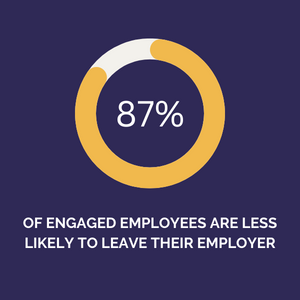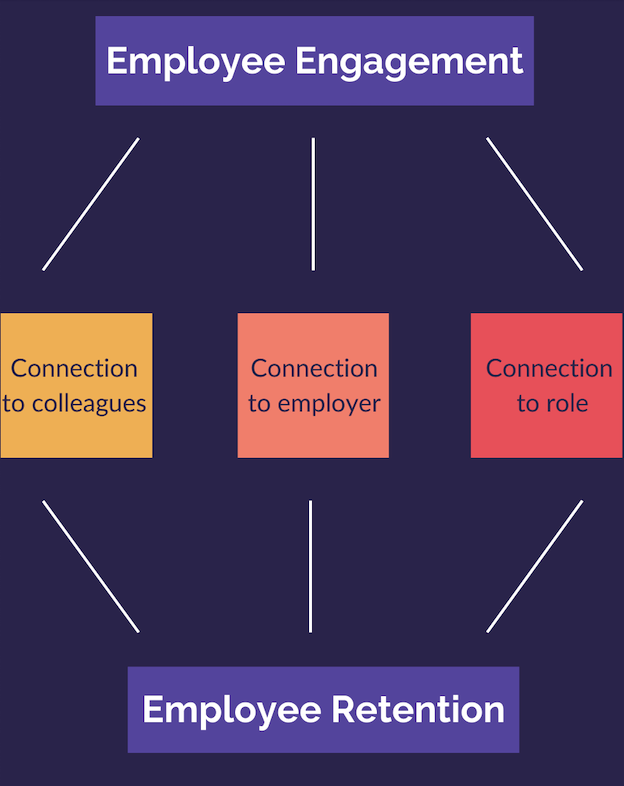Employee engagement contributes to retention.
The more mentally and emotionally connected an employee is to their roles, colleagues, and employer, the less likely they are to look for a new role. In fact, highly engaged employees are 87% less likely to leave their employer.

Engaged employees care if the company succeeds and, as a result, strive to produce quality work while working to maintain healthy relationships with their colleagues.
However, only 15% of employees feel engaged in their workplace. To help the other 85% establish a natural connection with their roles, colleagues, and employers, introducing workplace giving into your organization is beneficial.
To further illustrate this statement, we look at the relationship between workplace giving and employee engagement under three realms: how workplace giving connects employees to colleagues, connects employees to their employer, and connects employees to their role.

1. Workplace giving connects employees to their colleagues
Employees working across different departments might never have the opportunity to work together under normal working conditions, resulting in reduced human connections. And with 8 in 10 employees working remotely or hybrid, even employees working on the same team can struggle to form relationships over video calls.
What happens when workers don’t feel connected to one another? They feel more stressed, less engaged at work, and overall, exude a lower level of happiness. However, through workplace giving, employees are able to communicate, collaborate, and form a sense of belonging with others who share similar interests.
Some workplace giving efforts that engage employees as a team include:
- Organizing a clothing drive to donate used clothing to a local women’s shelter.
- Executing a peer-to-peer fundraiser to help a local children’s hospital buy a new MRI machine.
- Volunteering at a food bank, collecting, and organizing non-perishable goods to be later distributed.
Connecting employees to one another extends beyond hosting team-building workshops, daily huddles, or brainstorming sessions. Workplace giving opens up new avenues for employees to come together, do good for a cause they all support, and get to know one another in a judgment-free zone: leading to that natural human connection to be formed.
2. Workplace giving connects employees to their employer
When an employer and employee operate on the same values, these shared values are what will form an employee’s emotional and mental connection to their employer.
Generosity, compassion, and attentiveness: these are a few core values that many employees embody on a personal level. These values are also deeply rooted within an organization through a workplace giving program.
When an organization demonstrates and enables employees to live out these values through a workplace giving program, employees feel a sense of belonging, making them feel more connected to their employer.
Let’s look at how these values are rooted in a workplace giving program:
Generosity
Generosity consists of frequently giving to others without being asked.
Workplace giving embodies generosity through the execution of company-wide volunteer days, peer-to-peer fundraisers, and corporate donations. Organizations, with the involvement of their employees, are dedicating time and allocating money to help a variety of nonprofits reach their goals and live out their missions through these altruistic efforts.
Compassion
Compassion is about showing concern and empathy for others.
Compassion can come in all forms, from donating time to contributing resources to causes in need. Specific initiatives from a workplace giving program might include: donating books to a seniors’ community center that has low funding or volunteering at a nonprofit that provides career services for those transitioning into the job force.
Attentiveness
Attentiveness means listening carefully to the needs of others at all times.
For instance, suppose an organization is selling cause-related merchandise on behalf of their local Boys & Girls Club and is involving their employees in the design and sales process. To solidify a price point, design, and the types of merchandise to sell, employees must listen closely to the needs of their organization’s nonprofit partner.
As we have seen from the above examples, workplace giving initiatives allow these values to emerge. Rather than values being written statements embedded within a company’s website, employees are able to practice these values as they participate in a workplace giving program.
And when organizational values become practiced by employees, rather than merely being read, employees will feel more closely connected to their employer.

3. Workplace giving connects employees to their role
When employees engage in philanthropic work, it will strengthen their purpose, enhance their self-confidence, and improve their emotional well-being. As employees partake in a workplace giving program, employees will find that the benefits derived from their work outside the office can also be gained from their work inside the office.
Let’s first examine how a workplace giving effort, in particular volunteering at a community garden, can provide employees with these benefits listed above:
- Improve emotional well-being: Employees are able to develop social connections with others by working together in a low-stress environment through a volunteer day, which improves their emotional well-being.
- Strengthen purpose: By planting a garden that can help families put food on the table, these employees will feel like the work they are doing has a purpose.
- Enhance self-confidence: Volunteering to ease food insecurity gives employees a natural sense of accomplishment. And when employees realize their accomplishments, their self-confidence increases.
When emotional well-being, purpose, and self-confidence are perceived through volunteering, employees will be more likely to realize their day-to-day jobs also reap these same benefits. An employee who understands that their purpose in volunteering is to make a difference in the lives of others can understand that their purpose at work is the same, as the work they do impacts the lives of their customers. The result? A stronger connection to their role in the workplace.
Workplace Giving & Employee Engagement
Workplace giving connects an employee to their employer, colleagues, and role—the foundation of employee engagement. With 75% of employees who engage in corporate giving programs likely to stay at their companies for longer, now is the time to foster a culture of giving.
Wanting to begin or ramp up your workplace giving efforts? Kambeo’s social impact platform provides your employees with ample giving opportunities to spur collaboration, build self-confidence, and find their purpose.



